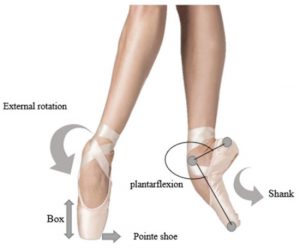Week 3: Pointe-ing to Tradition
Katie b -
For my spring break blog post, I would like to take a step back and further explain the history and significance of my project.
While the first pointe shoe was crafted in the nineteenth century, the physical structure of the shoes has only seen minor changes since then. Research into improving and modernizing a pointe shoe’s composition is a fairly new concept. Nobody had tried to use materials other than paper, cardboard, or leather–at least not until 1993 when the brand Gaynor Minden made its debut. Eliza Minden did the unthinkable and broke the traditional structure of the antiquated shoes by making her shanks and boxes with elastomerics. This same material is often found in medical prosthetics as well as a wide range of athletic equipment including athletic shoes. Yet this modernized approach is not widely accepted by all ballet dancers as many questioned whether the shoes were appropriate for elite-level dance. In 2002, Gaynor Minden shoes made their first appearance at the principal level when American Ballet Theater dancer Gillian Murphy performed her first principal role as Odette/Odile in Swan Lake. She received loads of backlash from former principal dancers claiming they were “cheater shoes,” and notably one dancer now refuses to refer to Gillian by name. Yet when Gaynor Minden shifted their marketing to younger dancers, they found that the upcoming generation is more willing to consider shoes with modern materials. Now in 2025, the controversy over modern shoes has faded drastically.
Younger dancers have come to realize the advantages of modern shoes specifically pertaining to the health and safety of pointe work. Dancing en pointe puts extreme strain on the foot and ankle of a dancer, especially the mid-foot flexion and plantarflexion. Mid-foot flexion is the expansion and contraction of the arch of the foot and it is closely related to plantarflexion which is the movement of pointing the top of your foot away from your leg.

Dancing on a “dead” shoe, one with a deteriorated shank and box, increases the angle of a dancer’s mid-foot flexion by over 6 degrees. This over extension of the mid-foot flexion and plantarflexion contributes to high risk of foot and ankle injuries in ballet dancers. The traditional materials of a pointe shoe are subject to faster breakdown than the newer, more modern materials used by Gaynor Minden. The invariable strength of modern pointe shoes has become a reason for young ballet students to turn away from traditional brands like Bloch, Freed of London, and Grishko. While stronger shoes like Gaynor Mindens are initially more expensive, they turn out to be less expensive in the long run due to the fact that they aren’t replaced as frequently. Recognizing the growing interest in a modernized pointe shoe, some people, including myself, have begun exploring new ways to innovate.

Comments:
All viewpoints are welcome but profane, threatening, disrespectful, or harassing comments will not be tolerated and are subject to moderation up to, and including, full deletion.